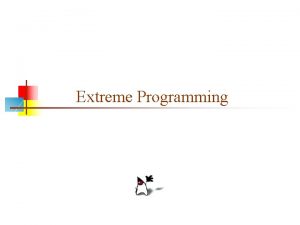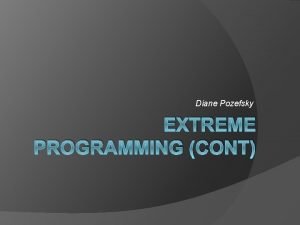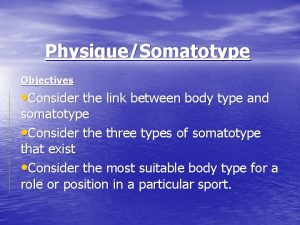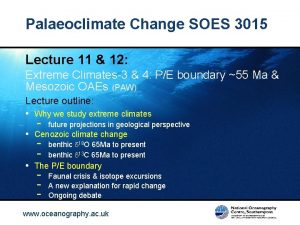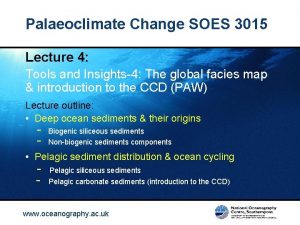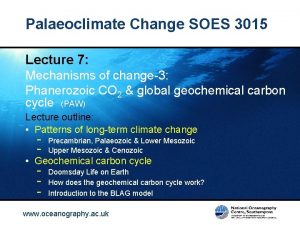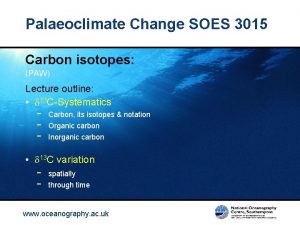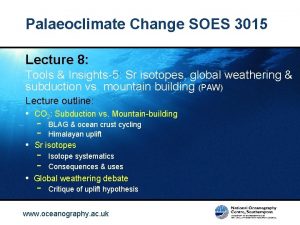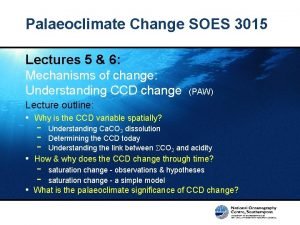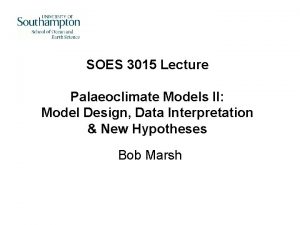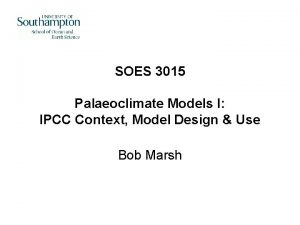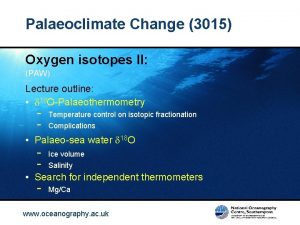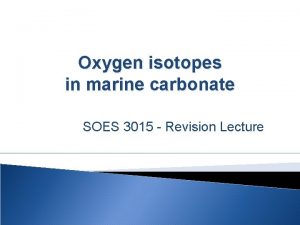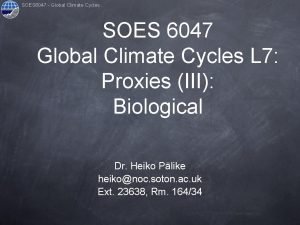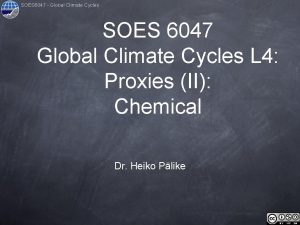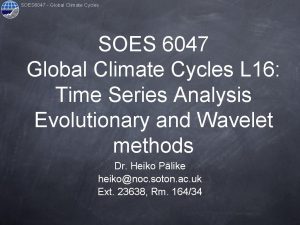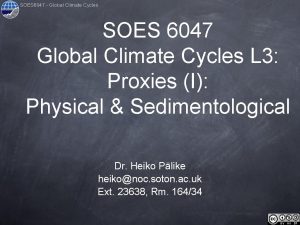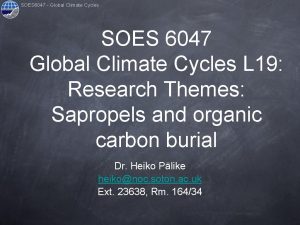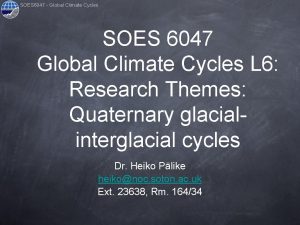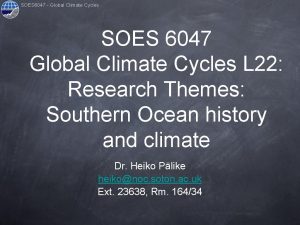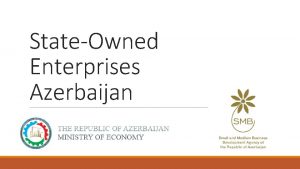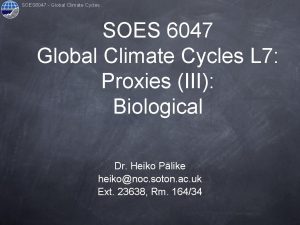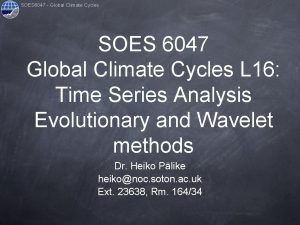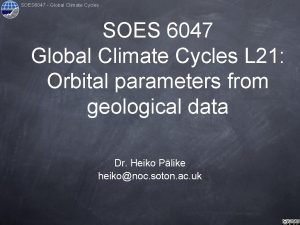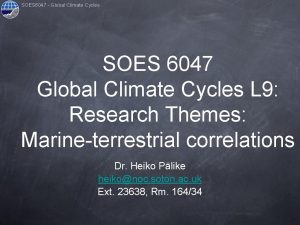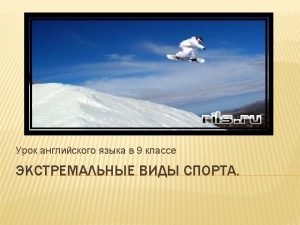Palaeoclimate Change SOES 3015 Lecture 11 12 Extreme


























- Slides: 26

Palaeoclimate Change SOES 3015 Lecture 11 & 12: Extreme Climates-3 & 4: P/E boundary ~55 Ma & Mesozoic OAEs (PAW) Lecture outline: • Why we study extreme climates • - future projections in geological perspective Cenozoic climate change - benthic O 65 Ma to present - benthic C 65 Ma to present 18 13 • The P/E boundary - Faunal crisis & isotope excursions A new explanation for rapid change Ongoing debate www. oceanography. ac. uk

(1) Why we study extreme climates • future projections in geological perspective (i) future projections in geological perspective Question: How high atmospheric p. CO 2 by 2100? Answer: 2 x Present Question: How does that compare w/ geological record? Answer: Examine the Vostock 18 O & foram 11 B records Courtesy IPCC Technical report.

Reproduced by permission from Macmillan Ltd: Climate and atmospheric history of the past 420, 000 years from the. Vostok ice core, Antarctica. J. R. Petit, J. Jouzel, D. Raynaud, N. I. Barkov, J. -M. Barnola, I. Basile, M. Bender, J. Chappellaz, M. Davis, G. Delaygue, et al. Nature, v. 399, p. 429 -436. Copyright (1999). Not under CC licence.

Reprinted by permisson from Macmillan Publishers Ltd: Atmospheric carbon dioxide concentrations over the past 60 million years. Pearson, P. N. , Palmer, M. R. Nature, v. 406, p. 695 -699. Copyright (2000). Not under CC licence.

Courtesy IPCC Technical report.

(2) Cenozoic climate change • benthic 18 O 65 Ma to present • benthic 13 C 65 Ma to present (i) benthic 18 O 65 Ma to present Question: Why focus on benthic records? Answer: They give clean globally representative signals Question: Why? Answer: Deep oceans are insulated from large seasonal, latitudinal & geographical variations in temp & salinity First order pattern 18 O 65 Ma to present: • long-term increase in 18 O • this pattern is dominated by a series of rapid “steps”

From: Zachos, J. C. , Pagani, M. , Sloan, L. , Thomas, E. , Billups, K. , (2001) ‘Trends, rhythms, and aberrations in global climate 65 Ma to present’, Science, v. 292, p. 686– 693. Reprinted with permission from AAAS. This figure may be used for noncommercial, classroom purposes only. Any other uses requires the prior written permission from AAAS. Question: Do these patterns represent cooling or ice growth? Answer: Primarily cooling before E/O boundary Significant ice after E/O boundary Evidence = presence or absence of IRD (non-quantitative) (more on E/O in next Lec)

(ii) benthic 18 O 65 Ma to present First order pattern 13 C 65 Ma to present: • wiggles back & forth between ~ +2. 5 & ‰ • 1º Cenozoic peak: Pal. (~58 -56 Ma) • 2º Cenozoic peaks: E/O bdy; O/M bdy & mid-Mio • 1º Cenozoic min: Plio-Pleistocene Question: What do these changes represent? Answer: Mechanisms open to debated but general agreement that reflects global balance in: Sedimentary burial of dead Corg (not photosynthesis) CO 2 + H 2 O = CH 2 O + O 2 (cf. prev Lecs) Oxidative weathering of dead sed. Corg (not respiration)

Recall that Corg is enriched in 12 C It follows that inc. burial to oxidation of Corg inc. 12 C extraction from global ocean inc. sea water 13 C inc. marine carbonate 13 C Extreme example = Mesozoic OAEs (oceanic anoxic events) The Selli Level (Early Aptian ) at Apecchiese Road (SS 257) km 33. The picture was taken during the fieldtrip of the Cyclostratigraphy Workshop (Perugia, 1989). Property E. Erba.

Sea water 13 C driven “heavy” becausec: 13 C of Corg ~ – 20 ‰ PDB 13 C of CO 3 ~ 0 ‰ PDB (cf. EJR lecs) CO 2 + H 2 O = CH 2 O + O 2 NB above equation indicates a control on climate via CO 2 Reproduced by permission of American Geophysical Union: Menegatti, A. P. , Weissert, H. , Brown, R. S. , Tyson, R. V. , Farrimond, P. , Strasser, A. , Caron M. , High-Resolution δ 13 C Stratigraphy Through the Early Aptian "Livello Selli" of the Alpine Tethys, Paleoceanography, v 13, no. 5, p. 530– 545. 19 May 1998. Copyright [1998] American Geophysical Union.

(3) The P/E boundary • Faunal crisis & isotope excursions • A new explanation for rapid change • Ongoing debate (i) Faunal crisis & isotope excursions Question: Why is the P/E bdy there? What makes it special? Answer : Forams say so Planktics - dwarf “excursion fauna” evolve for short time Benthics - suffer a mass extinction (significant ‘cos these sailed through the K/T bdy)

Question: What happens in the isotope records across the P/E bdy? Answer: both 13 C & 18 O show short-term –ve excursions These excursions are seen in • deep (benthic) and shallow (planktic) sea water • high and low latitudes • marine & terrestrial records Reproduced by permission of American Geophysical Union: Stott, L. , Higher temperature and lower oceanic p. CO 2: A climate enigma at the end of the Paleocene Epoch. Paleoceanography, v. 7, No. 4, p. 395. 19 may 1992. Copyright [1992] American Geophysical Union

18 O excursion • must reflect warming (formerly Late Paleocene Thermal Maximum, LPTM) (Pal greenhouse - no IRD, no ice-caps at this time) • most extreme in surface waters at high latitude & deep waters • by 5 to 8º C (huge) Reprinted by permission from Macmillan Publishers Ltd: Correlation between isotope records in marine and continental carbon reservoirs near the Palaeocene/Eocene boundary. Paul L. Koch, James C. Zachos, Philip D. Gingerich. Nature, v. 358, p. 319 -322. Copyright (1992) Not under CC licence.

Question: What caused such a dramatic warming? Answer: Most obvious suggestion = an increase in atms p. CO 2 Quetion: What might have caused an increase in atms p. CO 2? Answer: Correlative –ve 13 C excursion is providing big clue Question: Was there a dec. in burial-to-oxidation balance of Corg? ? sedimentary burial of dead Corg CO 2 + H 2 O = CH 2 O + O 2 (cf. prev Lecs) oxidative weathering of dead sed. Corg such that dec. burial to oxidation of Corg dec. 12 C extraction from global ocean dec. sea water 13 C dec. marine carbonate 13 C Answer: No: • acts too slowly (on Ma time-scales) • would require too big a change in flux of Corg into ocean-atms system ( 13 C Corg only ~ -20‰ PDB)

(ii) A new explanation for rapid change Question: Is there a source of C w/ sufficiently low 13 C to make the change in flux reasonable? Answer: Yes = methane as marine gas hydrates Question: What are gas hydrates? Answer: Solid CH 4 frozen in “cage” of water molecules: • stable @ low temperature & high pressure • form within sediments along continental margins • via bacterial processes (~ -65‰ PDB) • huge reservoir of carbon “hidden” from ocean-atms From: University of Southampton

Dickens (95) uses a geochemical box model to show that we can explain P/E –ve 13 C excursion via: • inject 1018 g CH 4 (-65‰ PDB) • over 104 yr • represents ~10% est. present reservoir) Question: Why is this important? Answer: Provides mechanism for rapid palaeoclimate change CH 4 + 2 O 2 = CO 2 + 2 H 2 O (directly analogous to burning of fossil fuel) This realisation has stimulated a flurry of new research… Courtesy of GSA: Dickens, G. R. , Castillo, M. M. , Walker, J. C. G. , A blast of gas in the latest Paleocene: Simulating first-order effects of massive dissociation of oceanic methane hydrate. Geology (1997), v. 25, p. 259 -262,

(ii) Ongoing debate Question: Was the CH 4 -injected during a single instantaneous event? Answer: Debate - possibly a series of “steps” High lat Low lat From: Bains S. , Corfield R. M. , & Norris R. D. , (1999) Mechanisms of climate warming at the end of the Palaeocene: Science, v. 285, p. 724 -727. Reprinted with permission from AAAS. This figure may be used for non-commercial, classroom purposes Only. Any other uses requires the prior written permission from AAAS.

Question: How rapid was the inferred CH 4 -induced warming? Answer: Injection occurred in a single precession cycle (~20 ka) Reprinted by permission from Macmillan Publishers Ltd: Carbon cycling and chronology of climate warming during the Palaeocene/Eocene transition Norris, R. D. , Röhl, U. Nature, v. 401, p. 775 778. Copyright (1999). Not under CC licence.

Question: What was the trigger? Answer: Debate- mass erosion; sea level fall; deep water warming Reproduced by permission of American Geophysical Union: Katz, M. E. , Cramer, B. S. , Mountain, G. S. , Katz, S. , Miller, K. G. , Uncorking the Bottle: What Triggered the Paleocene/Eocene Thermal Maximum Methane Release? Paleoceanography, v. 16, No. 6, p. 549– 562. December 2001. Copyright [2001] American Geophysical Union. Reproduced by permission of American Geophysical Union : Dickens, G. R. , O'Neil, J. R. , Rea, D. K. , Owen, R. M. Dissociation of Oceanic Methane Hydrate as a Cause of the Carbon Isotope Excursion at the End of the Paleocene Paleoceanography, v. 10, No. 6, p. 965– 971. 5 July 1995. Copyright [1995] American Geophysical Union.

Question: What prevented a runaway greenhouse? Answer: Debate- inc. in CO 2 draw-down from inc. productivity? Reprinted by permission from Macmillan Publishers Ltd: Termination of global warmth at the Palaeocene/Eocene boundary throughproductivity feedback Bains, S. , Norris, R. D. , Corfield, R. M. , Faul K. L. , Nature, v. 407, p. 171 -174. Copyright (2000). Not under CC licence.

Que: What was the link to faunal turnover? Ans: Debate- warming? Anoxia? CCD shoaling? P/E CH 4 injection inc. CO 2 [CO 32 -] = A – [ CO 2] (see prev lec. ) Assuming that alkalinity is constant over the short event: inc. [ CO 2] dec. [CO 32 -] i. e. shoaling of CCD Courtesy of SGF: Dickens, G. R. , (2000), Methane oxidation during the Late Palaeocene Thermal Maximum. Bull. Soc. Geol. France, v. 171, no. 1, p. 37 -39.

Is the P/E a “last Cenozoic fart” following the flatulence of the Mesozoic? Reprinted by permission of American Geophysical Union: Menegatti, A. P. , Weissert, H. , Brown, R. S. , Tyson, R. V. , Farrimond, P. , Strasser, A. , Caron M. , High-Resolution δ 13 C Stratigraphy Through the Early Aptian "Livello Selli" of the Alpine Tethys, Paleoceanography, v 13, no. 5, p. 530– 545. 19 May 1998. Copyright [1998] American Geophysical Union.

Some new evidence for –ve 13 C excursions associated with oceanic anoxic events (OAEs) P/E boundary event represents the best palaeoclimate analogue that we have for the modern anthropogenic experiment • rapid warming driven by massive release fossil fuel • fall in ocean CO 3 saturation • hidden positive feedbacks? Courtesy of SGF: Dickens, G. R. , (2000), Methane oxidation during the Late Palaeocene Thermal Maximum. Bull. Soc. Geol. France, v. 171, no. 1, p. 37 -39.

Modern hydrate = Organic = Gton Land biota = Soil = Dissolved marine = 14, 000 Gton ±? 3, 500 1, 500 Inorganic = Atmospheric = Ocean = 30, 000 30, 500 Gton 500 Global C cycle = 34, 00 Gton P/E injection = 1, 500 gton Anthropgn. Injection = 2, 000 Gton Reproduced by permission of American Geophysical Union: Archer, D. , Kheshgi, H. , Maier-Reimer, E. , Dynamics of Fossil Fuel CO 2 Neutralization by Marine Ca. CO 3. Global. Biogeochem. Cycles, v. 12, No. 2, p. 259– 276. 25 February 1998. Copyright [1998] American Geophysical Union.

What can we learn about climate sensitivity to CO 2? methane hydrate cannot have been responsible if CO 2 sensitivity was as assumed (1. 5 - 4. 5°C) thus either P/E resulted from huge input of CO 2 (mechanisms unknown) From: Pagani, M. , Caldeira, K. , Archer, D. , Zachos J. C. , (2006) Atmosphere: An Ancient Carbon Mystery. Science, v. 314, p. 1556 -1557. Reprinted with permission from AAAS. This figure may be used for non-commercial, classroom purposes only. Any other uses requires the prior written permission from AAAS. or climate sensitivity to CO 2 was higher

Copyright statement This resource was created by the University of Southampton and released as an open educational resource through the 'Cchange in GEES' project exploring the open licensing of climate change and sustainability resources in the Geography, Earth and Environmental Sciences. The C-change in GEES project was funded by HEFCE as part of the JISC/HE Academy UKOER programme and coordinated by the GEES Subject Centre. This resource is licensed under the terms of the Attribution-Non-Commercial-Share Alike 2. 0 UK: England & Wales license (http: //creativecommons. org/licenses/by-nc-sa/2. 0/uk/). However the resource, where specified below, contains other 3 rd party materials under their own licenses. The licenses and attributions are outlined below: • The University of Southampton and the National Oceanography Centre, Southampton and its logos are registered trade marks of the University. The University reserves all rights to these items beyond their inclusion in these CC resources. • The JISC logo, the C-change logo and the logo of the Higher Education Academy Subject Centre for the Geography, Earth and Environmental Sciences are licensed under the terms of the Creative Commons Attribution -non-commercial-No Derivative Works 2. 0 UK England & Wales license. All reproductions must comply with the terms of that license. • All content reproduced from copyrighted material of the American Geophysical Union (AGU) are subject to the terms and conditions as published at: http: //www. agu. org/pubs/authors/usage_permissions. shtml AGU content may be reproduced and modified for non-commercial and classroom use only. Any other use requires the prror written permission from AGU. • All content reproduced from the American Association for the Advancement of Science (AAAS) may be reproduced for non commercial classroom purposes only, any other uses requires the prior written permission from AAAS. • All content reproduced from Macmillan Publishers Ltd remains the copyright of Macmillan Publishers Ltd. Reproduction of copyrighted material is permitted for noncommercial personal and/or classroom use only. Any other use requires the prior written permission of Macmillan Publishers Ltd
 Extreme wide shot (news)
Extreme wide shot (news) 01:640:244 lecture notes - lecture 15: plat, idah, farad
01:640:244 lecture notes - lecture 15: plat, idah, farad Reactive change is change that
Reactive change is change that What is a phisical change
What is a phisical change When does a physical change occur study jams
When does a physical change occur study jams Whats the difference between a chemical and physical change
Whats the difference between a chemical and physical change Input and output markets
Input and output markets Climate change 2014 mitigation of climate change
Climate change 2014 mitigation of climate change Chemical change and physical change
Chemical change and physical change Absolute change and relative change formula
Absolute change and relative change formula Physical or chemical change
Physical or chemical change Change in supply and change in quantity supplied
Change in supply and change in quantity supplied Spare change physical versus chemical change
Spare change physical versus chemical change Integer
Integer First order change examples
First order change examples Enagic compensation plan
Enagic compensation plan Painting a wall chemical or physical change
Painting a wall chemical or physical change Rocks change due to temperature and pressure change
Rocks change due to temperature and pressure change Whats the difference between physical and chemical change
Whats the difference between physical and chemical change Is chopping wood physical or chemical change
Is chopping wood physical or chemical change Extreme terpz
Extreme terpz Extreme programming
Extreme programming Mantle meaning geography
Mantle meaning geography Extreme programming diagram
Extreme programming diagram Rowenta air force extreme rh8829wo
Rowenta air force extreme rh8829wo Extreme mesomorph
Extreme mesomorph Extreme programming model
Extreme programming model





















